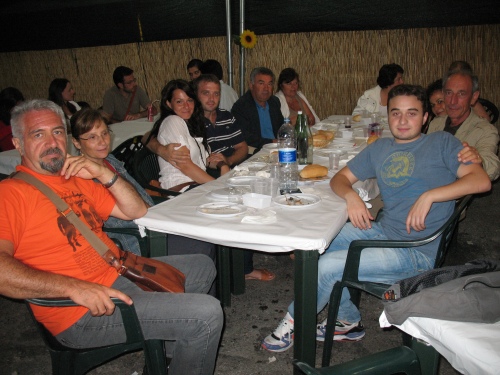Nocara — Exhibit Opening and Conference
August 6, 2010 by ruthellengruber | Edit
The event in Nocara August 4 opening the permanent exhibit of works that Shirley Moskowitz did there in the 1970s and 1980s and donated to the village 10 years ago was a great success – and lots of fun. The art works — townscapes, landscapes and portraits, mainly in watercolor, ink or pencil — are hung in the Town Council meeting room, and this, says Mayor Franco Trebisacce, is where they will remain, as a testament to the history of the village at a time when it was just on the verge of change from the age-old traditional lifestyle to modernity.

The speakers — two professors from the University of Cosenza and Vincenzo Salerno, the former longtime mayor of Nocara — discussed both the context of the works as well as the development of the village and the importance of the collection, and what it represents, for the town. Salerno recalled that Mom and Dad visited Nocara for lengthy periods of time over several years, at various seasons of the year. He noted that back then, it was still a largely peasant society, where donkeys were used for transport and animals were kept in town. Few men under retirement age lived in town, as most had immigrated northward to find work. Sam then spoke about the art itself. And we were presented with an engraved plaque as thanks for Mom’s work.

Dad gave a very moving little speech about Mom and her life as an artist — I recorded it and will try to post as an mp3.


There was an enthusiastic turnout, including a number of people who remembered Mom and Dad from the old days. Many people came up to Dad to reminisce — and Dad’s Italian rose to the occasion. The few people I knew from my own two visits to Nocara many years ago were there — and even to me recognizable, including Vincenzo Salerno, his brother Cici, and Giuseppe and Maria De Mateo.
There were several people in attendance who now, as adults, were able to see the portraits Mom did of them as children. Few of these people still live in Nocara (though some were back for summer vacation). Ernesto (shown here) is one of the few younger people who still lives in the town. We kept hearing over and over that Nocara is now was just “a town of old people.”
The event kicked off the annual summer pork festival (Festa del Maiale) — and the evening concluded amid an outdoor grilled feast, loud music, and dancing in the piazza. (Including with Cici Salerno — with whom I remember dancing in the piazza in 1981!)


The festival culminates with a big religious procession of the Madonna on August 15, either to or from the old monastery chapel of Santa Maria degli Antropici way down a very winding road from the village.

The speakers — two professors from the University of Cosenza and Vincenzo Salerno, the former longtime mayor of Nocara — discussed both the context of the works as well as the development of the village and the importance of the collection, and what it represents, for the town. Salerno recalled that Mom and Dad visited Nocara for lengthy periods of time over several years, at various seasons of the year. He noted that back then, it was still a largely peasant society, where donkeys were used for transport and animals were kept in town. Few men under retirement age lived in town, as most had immigrated northward to find work. Sam then spoke about the art itself. And we were presented with an engraved plaque as thanks for Mom’s work.

Dad gave a very moving little speech about Mom and her life as an artist — I recorded it and will try to post as an mp3.


There was an enthusiastic turnout, including a number of people who remembered Mom and Dad from the old days. Many people came up to Dad to reminisce — and Dad’s Italian rose to the occasion. The few people I knew from my own two visits to Nocara many years ago were there — and even to me recognizable, including Vincenzo Salerno, his brother Cici, and Giuseppe and Maria De Mateo.
There were several people in attendance who now, as adults, were able to see the portraits Mom did of them as children. Few of these people still live in Nocara (though some were back for summer vacation). Ernesto (shown here) is one of the few younger people who still lives in the town. We kept hearing over and over that Nocara is now was just “a town of old people.”
The event kicked off the annual summer pork festival (Festa del Maiale) — and the evening concluded amid an outdoor grilled feast, loud music, and dancing in the piazza. (Including with Cici Salerno — with whom I remember dancing in the piazza in 1981!)


The festival culminates with a big religious procession of the Madonna on August 15, either to or from the old monastery chapel of Santa Maria degli Antropici way down a very winding road from the village.








